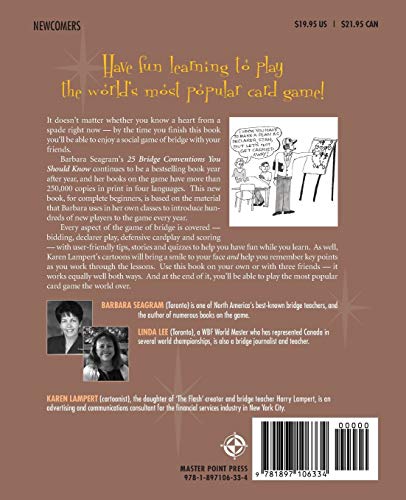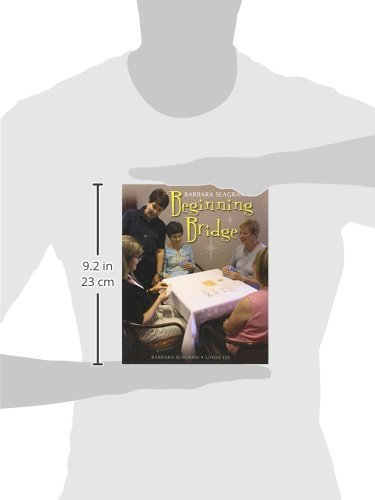



Beginning Bridge
D**V
Good Starter Book Before More Lessons
This is a very good book to get started. I went from zero to "up to speed" for a class that had been running 6 months and I was just starting. The bidding comes with the first read. The play sections are understood better (and should be reread) after some playing.
S**T
Beginning Bridge
This book is likely to be highly rated by ACBL and ABTA and may well be the best of its kind. And yet, it has some glaring shortcommings.First there is no index, only a Glossary without any page references.It does not recognize the ten card(T) as an honor card nor does it mention the Rule of 20, which is in the text.Next, every student needs to be made aware that there are primary, A and K, and secondary(Q,J and T)honor cards. Most bridge books will tell you that the primary honors are slightly undervaued on the Work-Goren point count scale,while the secondary ones are a bit overvalued.Thus unless a hand has an equal number of each kind an adjustment needs to be made in the HCP count.This difference can be expressed in terms of quick tricks, which come from combinations of A,K and Q, and has been part of hand evaluation during the past century. But this valuable concept is not mentioned.In addition there are a few other changes to the point count recommended by the master players and teachers of the old school but now left out as too hard for beginners to learn.This is part of an ongoing effort to dumb down education in all forms of teaching in the hope of attracting more students.A hand is also evaluated interms of its shape and distribution of number of cards per suit. For a long time during the past century there were two methods used, viz. the Goren short suit count, (1-2-3) and the Karpin long suit count of 1 pt for each card over 4 in any suit, with the first having been most popular, but gradually replaced by the Karpin count, so that ACBL favors it and is now used by the majority of players. Most new books now use it. This book mentions both as yielding about the same results most of the time and is illustrated with hands where there is no difference. Strictly speaking, 99.5% of all hand patterns cover 23 of the 39 possible patterns, but only 7of them yield identical counts, while 14 differ by one pt and two (4-4-4-1 and 5-4-4-0) differ by two pts.The world class player and prolific bridge author E.Kantar warns againstthe short suit count in "Bridge for Dummies" with this sage advice: 'Somebridge players fall in love with singletons and voids. They love them so much that they count extra points for them right off the bat. Do everything you can to avoid becomming one of them. They are a tradgedy waiting to happen, because they fail to appreciate that short suits are good only when you have support for your partner's suit. You need a good fit before you can count extra points for short suits." Thus Kantar has adopted to old saying "Don't count your chickens before they are hatched".There is no compelling reason for using the short suit count, when the majority of teachers and students use the long suit count.But knowing about it can be helpful when playing with a new partner. Also, the short suit count tends to get confused with "dummy poins".It is unrealistic to count points for shortness in the major suits, when the primary goal of bidding is to locate an 8-fit in a major suit.Disregarding the above criticism the book has many attractive features and is likely to become popular with teachers and students as well as self-learners.
R**T
Listed a like new. Not so as it was more like used plenty
Ended up buying another new one. Won’t buy used again!
K**S
Good and Prompt
The book was the book. It's hard to find a copy. The mailing was prompt and received as stated. Things happened as they should have.
B**R
GREAT FOR BEGINNER'S
This text gives students the sound basics to play bridge with confidence.rleteach
S**N
A very comprehensive primer
I bought this book because I noticed a growing attraction to the game, and I wanted to understand it better. It is a very basic, easy to understand game, that takes on a lot of intricacies one the bidding starts.I, personally, did not get the "Bridge Bug," but at least, thanks to this book, understand better how to play. I recommend the book for anyone, even if they are just like me, and only want to know what all the fuss is about.
F**L
Excellent
I'm just learning how to play bridge, and have bought several books to help me, including others by Barbara Seagrams. This is undoubtedly the best book for beginners (forget the "for Dummies" and "for Idiots" series) that I've encountered.
D**N
Four Stars
excellent guide- probably more than 4 stars
J**D
Five Stars
very good but american
J**S
A very basic book
If you like the books for dummies, this may be for you. It's a very simple look at bridge. Written in a very flowery way. It uses terms like your hand blooming, instead of stating the hand has improved when you have a match with your partner. Not my taste.
M**F
Excellent
Great book. It's not the author's fault that I can't find anyone to play with.
C**P
Five Stars
The best beginner’s bridge book going
Trustpilot
1 week ago
2 months ago